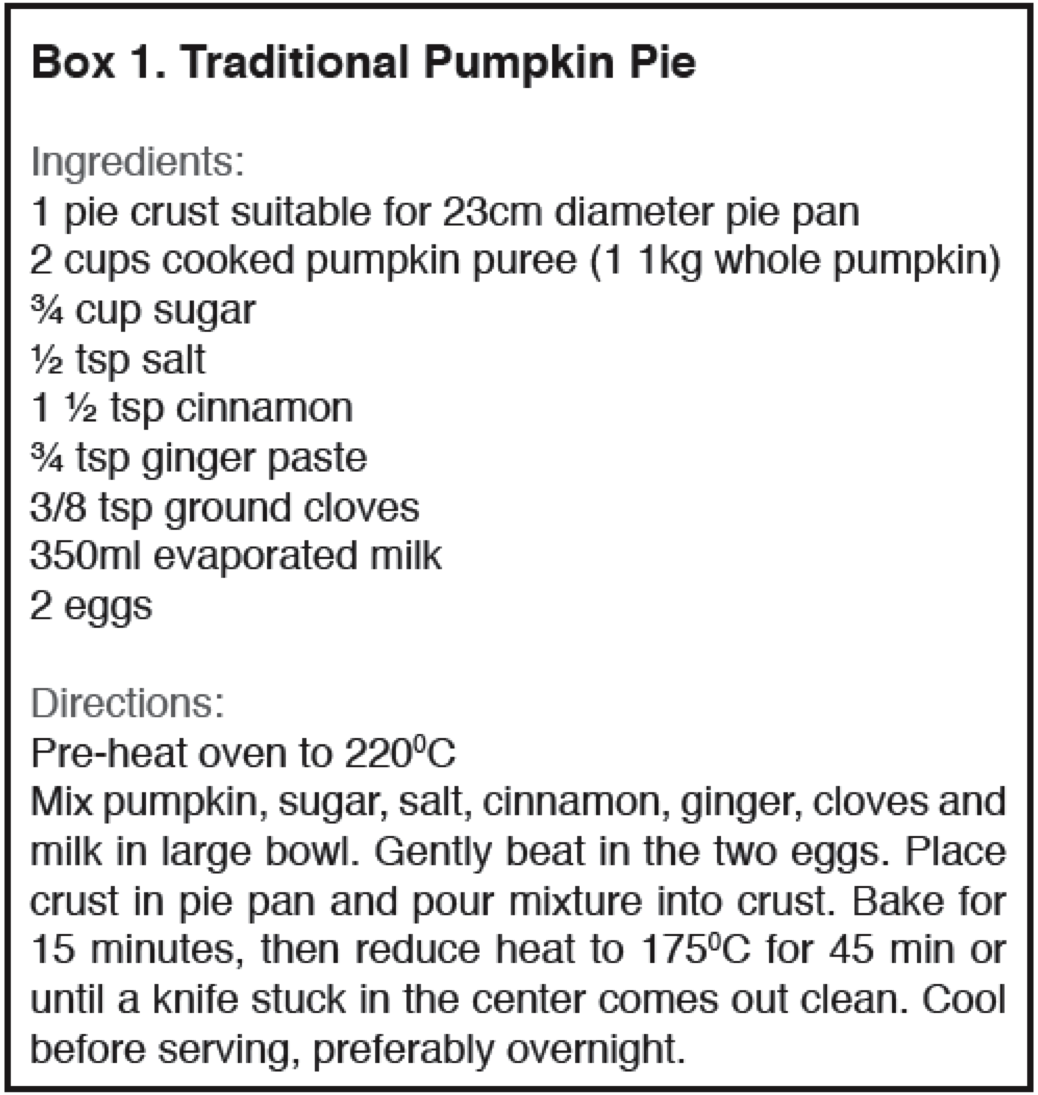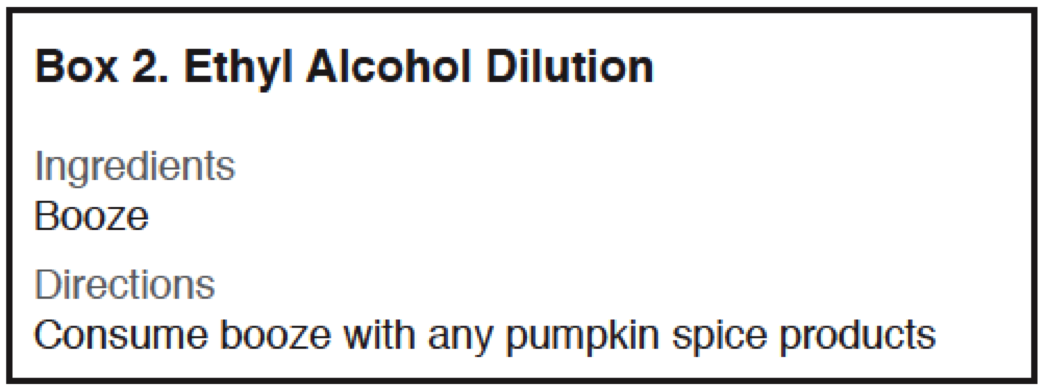
Tweet
November 6, 2014
Proceedings of the Natural Institute of Science | Volume 1 | HARD 6
Peak Pumpkin Spice: When will it end?: The indefinite analysis.
J. Olan Tern1 and L. van Pelt1
1 - Sleepy Hollow Pumpkin Academysubmitted: October 28, 2014
accepted: October 28, 2014

Introduction
Pumpkins (Cucurbita pepo) are a widely cultivated squash species native to the New World which have been cultivated for millennia, with at least a shit-ton of common varieties. Traditional uses of pumpkins center around harvest festivals celebrating the successful end of growing seasons. One popular tradition involves young children painstakingly carving faces into pumpkins, which are set on doorsteps at night as sacrifices to spirits. If the spirits find these sacrifices acceptable, the pumpkins are smashed, fertilizing fields and ensuring continued bounty; if unacceptable, they are left to rot as a symbol of familial dishonor. Historically, the only other acceptable use of pumpkins was the baking of pumpkin pie, a sweet-spiced custard baked in a flaky crust (Box 1).
In recent years, there has been a dramatic shift in pumpkin culture. The United Nations Populations Division reports that more than half of the global population now lives in cities (WHO UNPD 2014). The associated decline in agrarian lifestyles has disconnected many people from the traditional harvest festival, such that the mere flavor (i.e., the spice palate) of pumpkin pie now takes on many symbolic roles previously filled by actual pumpkins. It is widely believed that the Starbucks brand of coffee shops precipitated the explosion of pumpkin spice products with the introduction of their pumpkin spice latte in 2003 (Anon 2014). In the wake of the resulting cultural upheaval, a plethora of pumpkin spice flavored products have been brought to market. There are indications, however, that the current popularity of pumpkin spice has gone too far. Pumpkin spice products now include beer (Adams 2014)! There are rising murmurings against pumpkin spiced everything from many corners of the world. As a society, we may have now reached “Peak Pumpkin Spice,” (Mitchell 2013) the turning point in this ridiculous products popularity.
The growing discontent with the rapid invasion of pumpkin spice has been previously lamented as far back as 2013 (Davies 2013, Schmich 2013, Young and Hobson 2013). The concept of Peak Pumpkin Spice was introduced that same year by Mitchell (2013). These first calls-to-arms however went unheeded. Early accounts from 2014 were the first to quantitatively describe the growth of pumpkin spice hysteria (Jones 2014). Though recent work by Oliver (2014) is probably funnier, none of these previous attempts were as serious or nerdy about ecologically and mathematically exploring this problem as us.
Here, we explored the evolution of the pumpkin spice trend over the last ten years to answer the question “Good god, when will this madness end?”. Specifically, we investigate long-term annual and seasonal temporal trends in pumpkin spice interest. We then see if peak season interest can be predicted based on these trends in pumpkin peak phenology (seasonal timing) and total volume.
Methods
Data Collection - As a proxy of global interest in pumpkin spice products, we used Google Trends (google.com/trends; see Jones 2014) to retrieve the weekly normalized search volume for the term, “pumpkin spice” from the first week of 2004 (the first week data is available) through the week ending October 18th, 2014 (Fig. 1). The Google algorithm automatically includes results for related search terms such as “pumpkin muffin recipe”, “pumpkin spice latte”, and “OMG – is that a new i-phone?”. We thought to use other search engines, but neither author could remember what any of them were, and when we Googled “search engines”, a small tear in space-time appeared and the search was abandoned.
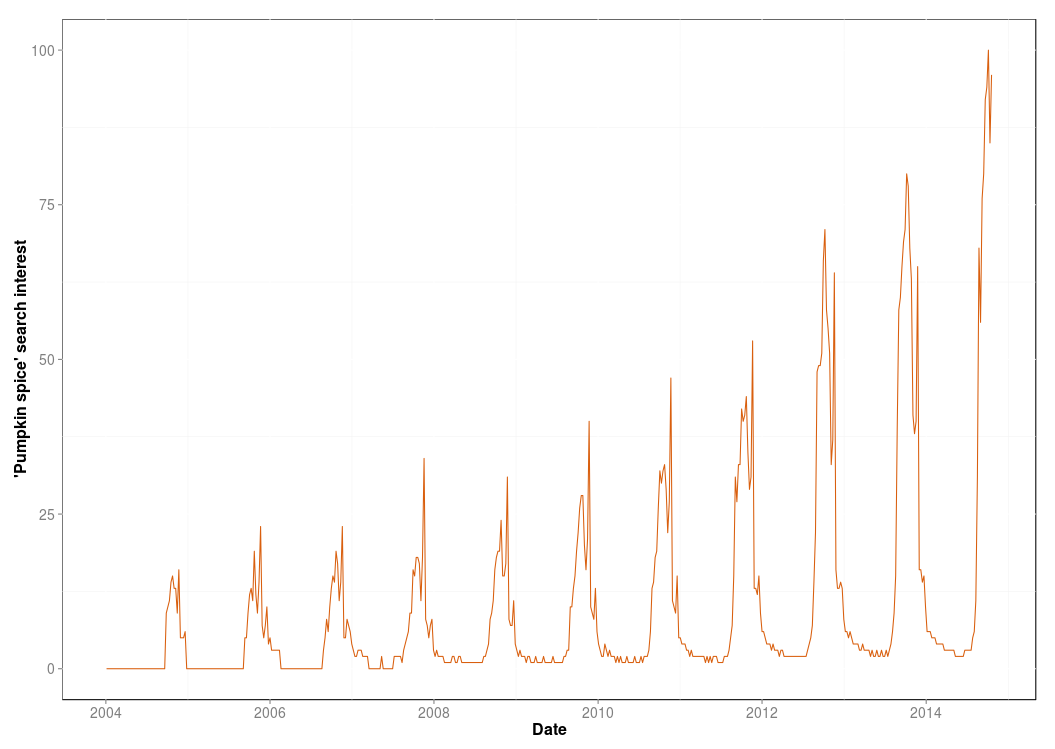
Each week in the dataset was assigned to a pumpkin-year associated with the harvest season. That is, for example, January 2014 pumpkin searches were assigned to the 2013 harvest. Initial examination of the data revealed that peaks in pumpkin spice search interest were centered near Halloween (October 31), so Halloween was assigned week zero to best center annual peaks for analysis.
Statistical Analyses – First, we smoothed the raw data of Fig. 1 into one unjagged line using a cubic spline[1] with a spar value of 0.5, because that looked pretty good. We identified the date of the maximum peak pumpkin spice as the maximum of the smoothed spline. The start of the pumpkin hump in each year was identified as the first week in the season where the first derivative of the spline was greater than one. Similarly the end of the peak was defined as the first week after the peak where the first derivative was less than one.
To model future interest in all things pumpkin spice, we first calculated the sum of the raw data between the identified start and end dates. This calculation gave the total annual interest in pumpkin spice. This number was fit to: 1) an exponential growth curve (see example here) and 2) a “hump-shaped” quadratic function that looks like a peak (see example here). We reasoned that if the hump-shaped function was a better fit, we could then predict the future year in which the decline in pumpkin spice would begin, thank god. Also, a quadratic equation is easy to code. We compared the fit of both curves using Akaike’s Information Criteria (AIC), in which lower values indicate a better fit.
Results & Discussion
There is a disturbingly large increasing trend in the weekly pumpkin spice search volume over the last decade (Fig. 1). In each year, the pumpkin-peak appears to be bi-modal (two peaked). The first peak is typically centered just before Halloween, while a second, sharper peak is associated with Thanksgiving (US). The prominence of a “Thanksgiving” peak suggests that part of the first October peak in each year may be confounded by a Canadian Thanksgiving Effect because Canadians celebrate Thanksgiving on the second Monday in October, because otherwise they get frostbite or something. Since 2012, the October peak has been larger than the Thanksgiving peak, suggesting a fundamental change in the way pumpkins have transitioned from a Thanksgiving dessert, to something probably more insidious.
The seasonal timing of the pumpkin peak has shifted progressively and dramatically since 2004, starting almost 2 months earlier in 2013 than in 2004 and ending a week and a half later (Fig. 2). The week of maximum pumpkin interest has shifted earlier by nearly a month. These changes in pumpkin peak phenology are in contrast to many such changes found in the natural world as of late. As a result of climate change, the arrival of autumnal and winter cold weather is occurring later in the year (Magnuson et al. 2000). Because pumpkin products are traditionally associated with the arrival of seasonal weather conditions (that is, “football weather”), it would be expected that pumpkin peaks would also arrive later in the year, while in fact, the opposite appears to be true.
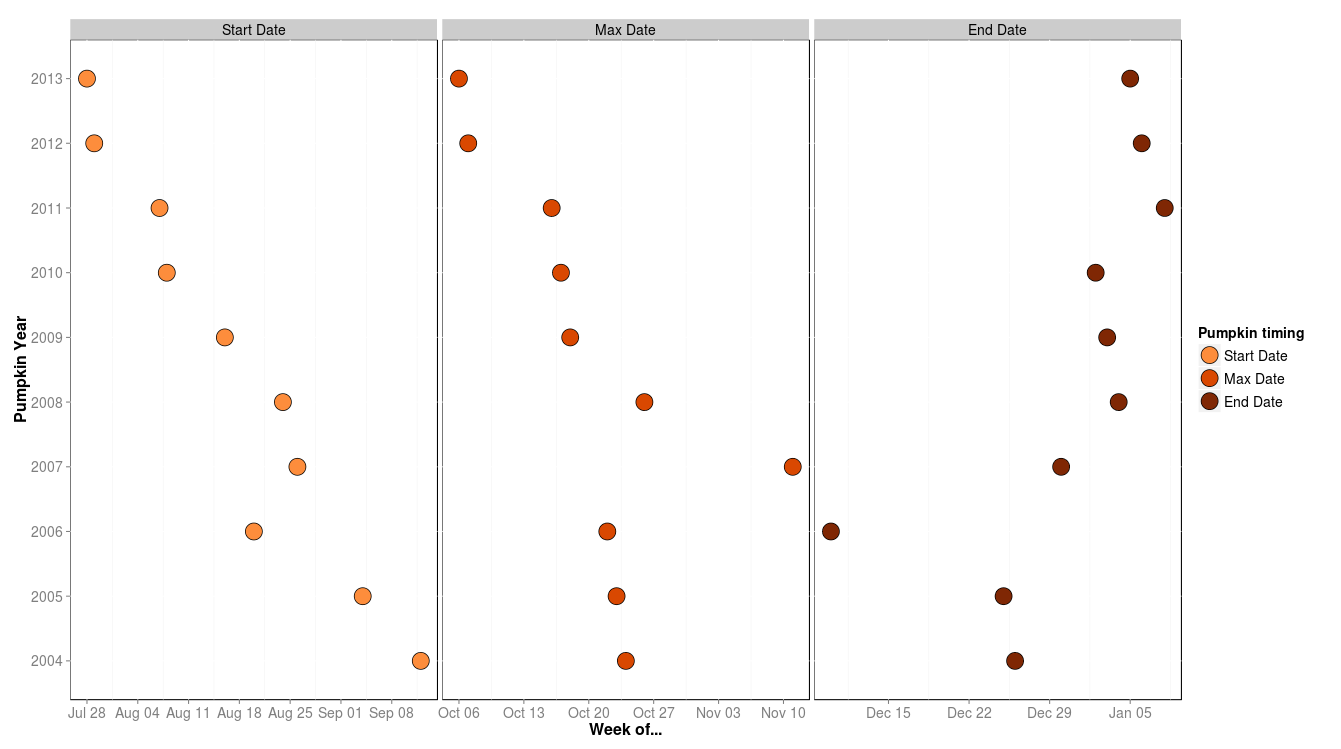
Mis-matches in seasonal timing due to climate change have serious implications throughout the natural world (Parmesan and Yohe 2003, Edwards and Richardson 2004). For example, flowering of many plant species coincides with the emergence of pollinating insects, but if climate change modifies the timing of flowering, but not pollinator arrival, both species suffer. We warn that shifts in the pumpkin peak towards warmer seasonal conditions in opposition of climate trends may seriously threaten co-occurring species, namely, yoga pants and brown leather boots. These species only emerge at cold temperatures and their sole source of calories seems to come from pumpkin spice products, despite an apparent symbiotic relationship with about half of the human population.
From our analysis, we observe that pumpkin spice interest will reach a seasonal minimum during the first week of November. This period may be a deceptive reprieve in the pumpkin spice frenzy but it is only an ominous “eye-of-storm”. From the historical trends, we can certainly expect a Thanksgiving (US) peak, but we cannot predict from the current data whether the coming 2014 Thanksgiving (US) peak will be smaller than the October peak as in the most recent prior years, or larger as in most of the historical data. That is, there is a real probability that things will get worse before they get better.
Finally, we considered the total pumpkin spice interest in each year over the last ten years to predict if there is any hope that this pumpkin spice craze may soon be over (Fig. 3). However, the exponential model (AIC= -43.9), rather than the peaking quadratic model (AIC = 70.5) was the best fit to the data. These model results imply either 1) No. It will never be over. Christ, like, ever. Our grandchildren will look back and ask not, “Why didn’t you do something about climate change” but rather “Why didn’t you kill it when you could?” Alternatively, 2) there is not enough data to accurately predict to the future.
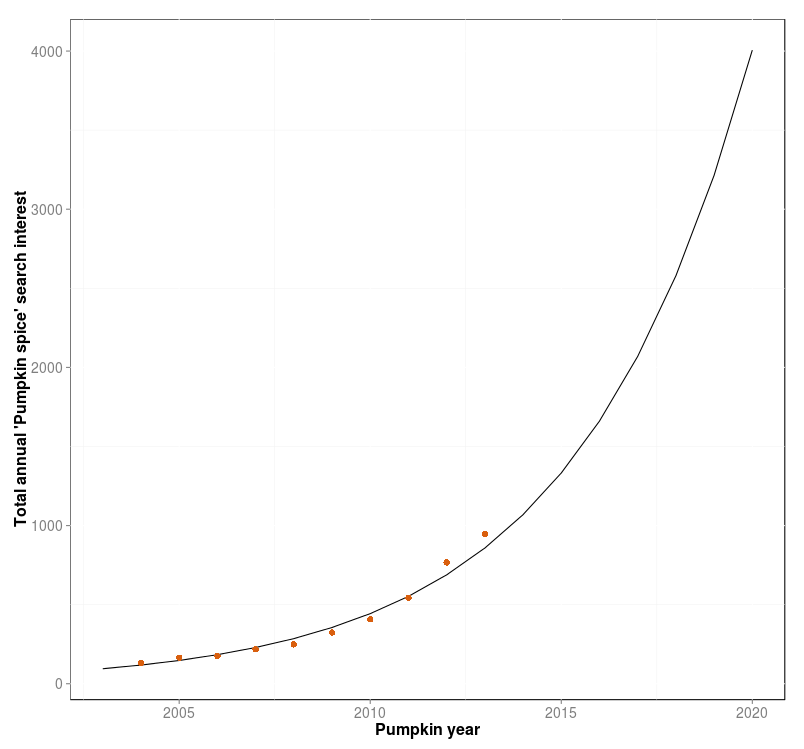
Conclusion
The growth in the popularity of pumpkin spice flavoring shows no indication of slowing down in the near future. In 2014, we expect a slight decline in interest before Thanksgiving (US), but this should not instill hope: there is likely to be a strong second peak. Looking to 2015 and beyond, we see no reason for optimism that the pumpkin spice craze is nearing completion. We suggest one mechanism to adapt to this unfortunate future is ethyl alcohol dilution, known as the “Grandma’s Nog” strategy (Box 2).
Acknowledgements
We thank one non-anonymous reviewer for helpful comments, as well as some asshole who probably has a small wiener.
References
Adam S. (2014) Harvest Pumpking Ale. SamuelAdams.com.
Anon (2014) Everything You Need to Know about the Return of Starbucks Pumpkin Spice Latte. Starbucks.com.
Davies M (2013) Everyone Needs to Calm the Fuck Down About Pumpkin Spice. Jezebel.
Edwards M and Richardson AJ. (2004) Impact of climate change on marine pelagic phenology and trophic mismatch. Nature 430:881-884
Jones LW (2014) Can the pumpkin spice craze get even bigger? Noted. lisawaananen.com.
Magnuson JJ, Robertson DM, Benson BJ, and so on (2000) Historical trends in lake and river ice in the Northern Hemisphere. Science. 289:1743-1764
Mitchell D (2013) Have We Reached Peak Pumpkin Spice? Modern Farmer.
Oliver J (2014) Pumpkins Spice (Web Exclusive). Last Week Tonight with John Oliver. Youtube.com.
Parmesan C and Yohe G (2003) A globally coherent fingerprint of climate change impacts across natural systems. Nature. 421: 37-42
Schmich M. (2013) October’s a wonder, but getting a bit over-pumpkined. Chicago Tribune. October 20, 2013.
UNPD. (2014). World Urbanization Prospects: The 2014 Revision, Highlights (ST/ESA/SER.A/352). (pp. 1–32). United Nations, Department of Economic and Social Affairs, Population Division.
Young R and Hobson J (2013) Have Pumpkin Products Jumped The Shark? Here and Now.
Footnotes
[1] Here’s a visual on how a cubic spline smooths jagged data. [Return to main text]

Proceedings of the Natural Institute of Science (PNIS) by https://instsci.org/ is licensed under a Creative Commons Attribution-ShareAlike 4.0 International License.
